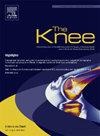三维模型显示股骨截骨部位不同,矫正效果也不同,可提高股骨截骨术的计划性和精确性 - 一项针对 8 个股骨和 2 名外科医生的观察研究。
IF 1.6
4区 医学
Q3 ORTHOPEDICS
引用次数: 0
摘要
背景:股骨外翻(FAV)是导致膝前疼痛(AKP)的关键因素,而股骨外翻截骨术(FDO)具有良好的临床效果。目前仍不清楚应在股骨的哪个水平进行截骨。用 Murphy's 方法测量的 FAV 度数并不总是与 FDO 后计划的度数一致。本研究的假设是股骨旋转轴与截骨旋转轴不一致。三维(3D)技术被用来确定这两个轴线之间的差异,并找到解决方案,使两个轴线能够重合。目的是通过一项观察者内部和观察者之间的研究,证明三维技术在截骨调整方面的可靠性和可重复性:方法:选取七名确诊为 AKP 且 FAV 增高的患者的八张股骨计算机断层扫描图像。两名外科医生在三维生物模型上进行FAV测量和FDO模拟。股骨截骨分为 10°、20° 和 30°三个级别。为确定观察者之间的一致性,由两名外科医生独立进行测量。为评估观察者内部差异,每位外科医生在 15 天后重复所有测量:观察者间和观察者内的一致性:类内相关系数分别为 0.930(95% 置信区间(CI)0.799-0.975)和 0.986(95% 置信区间(CI)0.959-0.995)。在转子间水平进行截骨时,观察到结果值之间存在显著差异:结论:在转子间水平进行截骨时,轴线的错位会导致矫正不足。结论:在转子间进行截骨时,轴线的错位会导致低校正,而在二骺或髁上进行截骨时则不会出现这种现象。本文章由计算机程序翻译,如有差异,请以英文原文为准。
Three-dimensional models demonstrate differences in correction depending on femoral derotational osteotomy site and may enhance the planning and precision in femoral derotational osteotomy – An observational study in eight femora and two surgeons
Background
Increased femoral anteversion (FAV) is crucial in the genesis of anterior knee pain (AKP) and a femoral derotational osteotomy (FDO) has demonstrated good clinical results. It remains unclear at what level of the femur the osteotomy should be performed. Resulting degrees of FAV measured by Murphy’s method do not always correspond to the degrees that had been planned after an FDO. The hypothesis of this study is that the femur rotation axis and the osteotomy rotation axis do not coincide. Three-dimensional (3D) technology is used to objectify the discrepancy between these two axes and to find solutions so that the two axes can coincide. The objective is to demonstrate the reliability and reproducibility of the 3D technique for osteotomy adjustment through an intraobserver and interobserver study.
Methods
Images of eight computed tomography scans of the femur, corresponding to seven patients with a diagnosis of AKP and increased FAV, were selected. Two surgeons performed the FAV measurement and simulation of FDO on 3D biomodels. The femoral osteotomies were defined at three levels, at 10°, 20°, 30°. To determine interobserver agreement, measurements were performed independently by two surgeons. To evaluate intraobserver differences each surgeon repeated all measurements after 15 days.
Results
Interobserver and intraobserver agreement: intraclass correlation coefficient 0.930 (95% confidence interval (CI) 0.799–0.975) and 0.986 (95% CI 0.959–0.995). Significant differences between the resulting values were observed when the osteotomy was performed at the intertrochanteric level.
Conclusions
The misalignment of the axes results in hypocorrection when the osteotomy is intertrochanteric. This phenomenon is not observed when the osteotomy is diaphyseal or supracondylar.
求助全文
通过发布文献求助,成功后即可免费获取论文全文。
去求助
来源期刊

Knee
医学-外科
CiteScore
3.80
自引率
5.30%
发文量
171
审稿时长
6 months
期刊介绍:
The Knee is an international journal publishing studies on the clinical treatment and fundamental biomechanical characteristics of this joint. The aim of the journal is to provide a vehicle relevant to surgeons, biomedical engineers, imaging specialists, materials scientists, rehabilitation personnel and all those with an interest in the knee.
The topics covered include, but are not limited to:
• Anatomy, physiology, morphology and biochemistry;
• Biomechanical studies;
• Advances in the development of prosthetic, orthotic and augmentation devices;
• Imaging and diagnostic techniques;
• Pathology;
• Trauma;
• Surgery;
• Rehabilitation.
 求助内容:
求助内容: 应助结果提醒方式:
应助结果提醒方式:


